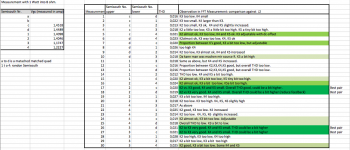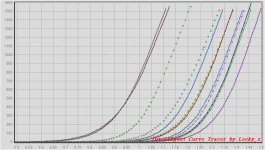Forgive me. It is not the gate resistor that had to be minimal, it is the pull down resistor at the input. In the F6 thread, he recommended 10-12K as max, due to leakage. I can only assume that this is to limit the the affect of that resistor interacting with leakage of SSr100. I understand higher capacitance requires greater drive current, just don't understand how leakage plays into the equation.
..... leakage plays into the equation.
it's having everything with impedance of biasing apparatus , same as with impedance of (AC , what else ) modulation aparatus ;
just imagine gate leakage as small current sink and what's then happening with voltages you brought to it ; and - what's most tricky part - that current sink isn't exactly constant
whatever - I'm not loosing my sleep too much over it , neither with matching issues

How close is close ? Did you check Vgs on all of them ?
Shame SS went belly up (though predictable from the onset), their latest R055 TO220's looked interesting, better make the most of them.
(btw,Buzz,the message was not about intellect. This place is a gathering of individuals who enjoy sound, and the technical side of audio. Instead of embracing the shared features, quite a few rather focus on what sets them apart, to broadcast their superiority. Looked closer, often more is shared in common. Sometimes it's a cat/dog, a liking for wine/food, or a cheap vampire flic. On the outside, difference can be a million bucks or a PhD apart)
Shame SS went belly up (though predictable from the onset), their latest R055 TO220's looked interesting, better make the most of them.
(btw,Buzz,the message was not about intellect. This place is a gathering of individuals who enjoy sound, and the technical side of audio. Instead of embracing the shared features, quite a few rather focus on what sets them apart, to broadcast their superiority. Looked closer, often more is shared in common. Sometimes it's a cat/dog, a liking for wine/food, or a cheap vampire flic. On the outside, difference can be a million bucks or a PhD apart)
I do have some matched pairs and quads of Semisouth.
But when building my J2-inspired amp, I did not get the results I wanted with the matched ones. Seemed matching for Vgs was not enough....
Out of frustation I took a matched pair and 4 random unmatched Semisouth.
This 6 transistors gave me 6*5 = 30 different combinations for upper and lower half in one F6/J2 channel.
I measured all 30 combinations for THD, 2nd, 3rd, 4th and 5th harmonic distortion.
Those pairs, that gave me the results I wanted, were not the pairs with best matching !
(yes, that is totally stupid approach, but it worked for me )
)
But when building my J2-inspired amp, I did not get the results I wanted with the matched ones. Seemed matching for Vgs was not enough....
Out of frustation I took a matched pair and 4 random unmatched Semisouth.
This 6 transistors gave me 6*5 = 30 different combinations for upper and lower half in one F6/J2 channel.
I measured all 30 combinations for THD, 2nd, 3rd, 4th and 5th harmonic distortion.
Those pairs, that gave me the results I wanted, were not the pairs with best matching !
(yes, that is totally stupid approach, but it worked for me
Attachments
Your results are what garnered my curiosity. Tha and what Ilquam found with F6. Maybe I get lucky nd shed the light on some of the reasons.I do have some matched pairs and quads of Semisouth.
But when building my J2-inspired amp, I did not get the results I wanted with the matched ones. Seemed matching for Vgs was not enough....
Out of frustation I took a matched pair and 4 random unmatched Semisouth.
This 6 transistors gave me 6*5 = 30 different combinations for upper and lower half in one F6/J2 channel.
I measured all 30 combinations for THD, 2nd, 3rd, 4th and 5th harmonic distortion.
Those pairs, that gave me the results I wanted, were not the pairs with best matching !
(yes, that is totally stupid approach, but it worked for me)
I gotta look for a certain TO220.
was inspired to get lockys lovely curve tracer and let it at my R100s...
These are from a random tubes bought from SS UK distributor. I bought 17 IIRC and 3 were DOA. These are the rest less two which are in an amp.
Tea-bags were 100As so I havent show them together with the above.
Depending on your standards I think I see between 2 and 4 pairs here....
These are from a random tubes bought from SS UK distributor. I bought 17 IIRC and 3 were DOA. These are the rest less two which are in an amp.
Tea-bags were 100As so I havent show them together with the above.
Depending on your standards I think I see between 2 and 4 pairs here....
Attachments
14pcs ?
I see them as 7 pairs
nasty Greedyboysess
life is good ....... and simple
gollumgollum

don´t you suppose out of your 7 pairs 5 will be divorced soon......
that´s life!
"gollumgollum" is the only nice pair I can see here...
Your in good shape with 4 pairs as i see it, especially in F6 like design. Test for gain next.
Buzz the gain is just the slope of above curves or is there some other spec gain tests I should do on the curve tracer ?
For my further invrstigation, i am going one dtep further and measuring two things. First gain. Ill do this by injecting actual AC signal into gate and meaduring response acrooss load. Second will be measuring gate leakage. These parts already have somewhat high leakage numbers,so the question is how consistent it is. If you see the post by dsdjoy, you can see just how mich variation you can get from an assortment of fets.
When you look at the distortion values dsdjoy showed on his J2 try,
you could say, I do not care for the small distortion difference of 0,012-0,028 %. But keep in mind that the distortion spectra concerning K2 and k3 was very different and that we were looking for the unique sound Nelson J2 had, so we were searching in the bits.......
J2 had, so we were searching in the bits.......
But some bits we never found.... AAAARG!
you could say, I do not care for the small distortion difference of 0,012-0,028 %. But keep in mind that the distortion spectra concerning K2 and k3 was very different and that we were looking for the unique sound Nelson
But some bits we never found.... AAAARG!
If I understand the information provided correctly, the devices with the A suffix (for Audio) has higher gate leakage.
SemiSouth reckons that the leakage is not important for audio, if I am not mistaken.
Patrick
You are correct on both accounts. During the yield sorting process while die were still on the wafer, die were measured as you might imagine for an assortment of specifications. Those 100 mOhm enhancement-mode die (the vast majority of wafer starts in the last two years of the company's life) that met all specifications including not exceeding 300 microamp reverse gate leakage at Vgs = -15V were sorted as R100 die. Those that passed the same specifications with the exception that they did not exceed 300 microamps gate leakage at Vgs = -10V were sorted as R100A.
Since class A biasing involves no reverse gate bias at all, audio looked like a safe place to market these parts that otherwise would not have left the building. My testing shows that really leaky parts might conduct unacceptable source current in forward bias, but most of the time what is "leaky" when measured on the gate is negligible compared to the drain current. I have a sleeve and a half of parts that indicated "shorted" gates on the curve tracer when tested for reverse-bias gate current, but are not particularly leaky under modest forward bias and produce normal output curves. I use these parts for testing amplifiers. I have no idea how long they will last under continuous power dissipation of 30-60 W, but I use them and they are not obviously distinguishable from "good" parts in operation.
The bottom line is that other than normal die-to-die variation, for class A biasing I doubt there is a difference between an R100 and an R100A that would warrant changing the gate bias resistors, or anything else for that matter, unless something unwise has been done to the transistor, then all bets are off.
- Status
- This old topic is closed. If you want to reopen this topic, contact a moderator using the "Report Post" button.
- Home
- Amplifiers
- Pass Labs
- Semisouth SJEP120R100 Power Loss

 If a PHD, then too bad, cause all I have is THD.
If a PHD, then too bad, cause all I have is THD.